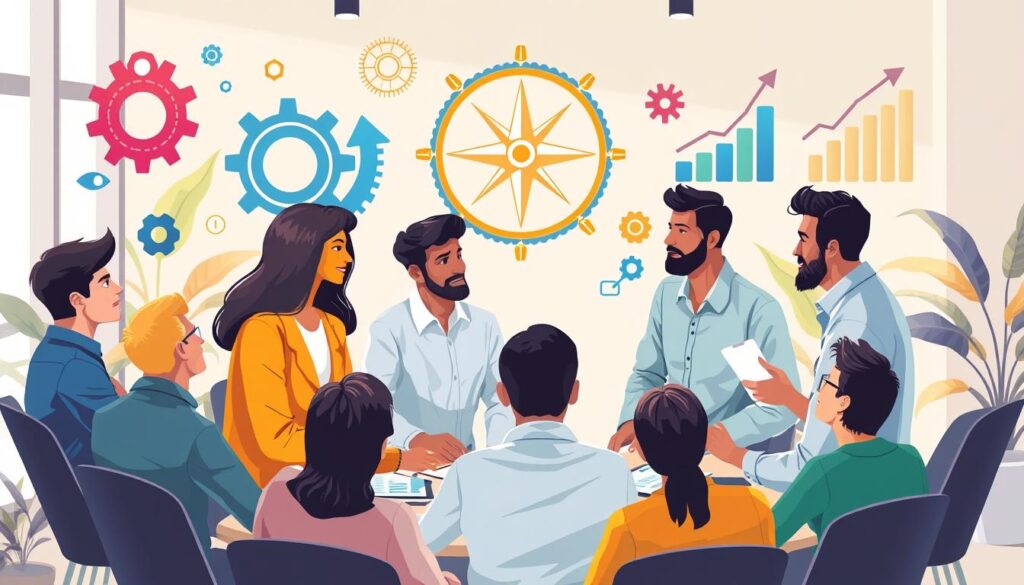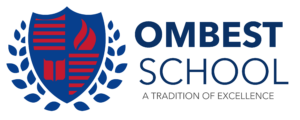Effective leadership is key for any organization’s success. Leadership development strategies help grow and empower leaders. They guide how to spot, check, and improve the skills and traits needed for great leadership.
By focusing on leadership development, companies can create a strong team of leaders. This team helps the company grow, innovate, and stay ahead in the market.
Key Takeaways:
- Leadership development strategies aim to identify, assess, and cultivate the skills, qualities, and behaviors required for effective leadership.
- Effective leadership development programs involve a variety of initiatives, such as training workshops, mentorship programs, coaching sessions, and experiential learning opportunities.
- Investing in leadership development can help build a pipeline of capable leaders, foster a culture of continuous growth and innovation, and strengthen an organization’s competitive edge.
- Successful leadership development programs align individual development plans with organizational goals, ensuring targeted and impactful results.
- Continuous learning and a focus on self-directed development are essential for cultivating a leadership mindset within an organization.
The Significance of Leadership Development Strategies
Creating a solid leadership development strategy is key for companies wanting to boost their employees’ skills. This plan helps spot future leaders and gives them the tools to grow their leadership skills. It also improves team performance and employee engagement, ensuring a steady flow of skilled leaders.
Enhancing Leadership Skills
Leadership development focuses on teaching leaders various skills. These include making decisions, solving problems, communicating well, and understanding emotions. Through a mix of classroom learning, hands-on experience, coaching, and mentorship, leaders become well-rounded. They can then inspire their teams, create a positive work environment, and help the company grow.
Improved Team Performance
Investing in leadership development makes leaders more effective. This leads to better team performance. Skilled leaders can motivate their teams, solve conflicts, and encourage teamwork. This results in higher productivity, happier employees, and better business results.
Increased Employee Engagement
Good leadership development strategies boost employee engagement. By offering growth chances, mentorship, and learning, companies show they care about their employees. This leads to happier employees, lower turnover, and a stronger team spirit. Happy and engaged employees help the company succeed and become valuable assets.
Aligning Leadership Development with Organizational Goals

Effective leadership development is more than just improving individual skills. It must align with the organization’s strategic goals. This way, leaders can achieve more focused and effective results. It helps the company succeed and empowers leaders to make a real difference.
Setting SMART (Specific, Measurable, Achievable, Relevant, and Time-bound) objectives is key. These goals give leaders a clear path to follow. They can see their progress and know their work is helping the company’s goals.
| Organizational Goals | Corresponding Leadership Development Objectives |
|---|---|
| Expand into new international markets | Develop cross-cultural communication and negotiation skills |
| Enhance operational efficiency | Strengthen problem-solving and decision-making capabilities |
| Improve customer satisfaction | Foster empathy, emotional intelligence, and client-centric leadership |
Regular feedback is vital to keep leadership development on track. Tools like one-on-one meetings, performance reviews, and 360-degree assessments are essential. They help leaders get feedback, adjust their strategies, and keep improving.
Aligning leadership development with organizational goals helps companies use their resources better. It drives the company’s strategic goals and fosters a culture of ongoing improvement. This approach not only helps leaders grow but also sets the company up for long-term success.
Assessing Leadership Needs and Gaps

Starting with a deep look at what an organization needs in leadership is key. This means checking out the current state of the organization and who would most benefit from leadership training. It’s about finding the right people for the right programs.
Evaluating Organizational Context
It’s important to understand the organization’s unique challenges and culture. This helps in creating leadership programs that really make a difference. By looking at the company’s culture, goals, and what leaders already know, organizations can make smart plans.
A study by the Center for Creative Leadership showed that 22% of people think dealing with tough employees is a big part of being a leader. Also, 18% said planning strategies is key to good leadership development.
Identifying Target Audiences
Leadership programs should fit the needs of the organization’s main players. This includes top executives, middle managers, and those with big potential. By looking at who needs help and where they can grow, companies can make sure their programs match their goals.
The study found that only 14% think respecting differences is a big part of leadership. But 12% said being a participative manager is crucial. Also, 11% saw cultural adaptability as important, and 10% said inspiring commitment is a must.
By really understanding what leadership gaps exist, organizations can make programs that meet their unique needs. This helps improve the leadership skills of their team, making them more effective.
Leadership Development
Effective leadership development is key for organizations to grow their future leaders. It includes mentorship, workshops, and action learning projects. These efforts help build a strong leadership team.
Mentorship Programs
Mentorship programs give new leaders a chance to learn from the best. They get one-on-one advice and support. This helps them understand leadership, improve their skills, and make professional connections.
Leadership Workshops
Leadership workshops are interactive and fun. They focus on skills like strategic thinking and communication. Participants learn through activities, case studies, and group talks.
Action Learning Projects
Action learning projects tackle real business problems. Leaders work together to solve these issues. They learn to make decisions based on data and find new solutions.
| Initiative | Description | Key Benefits |
|---|---|---|
| Mentorship Programs | One-on-one guidance and support from experienced professionals | Develop essential leadership skills, build a professional network |
| Leadership Workshops | Interactive programs focused on building key leadership competencies | Enhance strategic thinking, communication, and decision-making |
| Action Learning Projects | Collaborative problem-solving on real-world business challenges | Apply theoretical knowledge, develop innovative solutions |
Using different leadership development programs helps organizations grow. They create a culture of learning and ensure a steady flow of talent.
Implementing Effective Learning Experiences

Effective leadership development programs do more than just train. They create engaging experiences that connect with participants. This approach boosts the program’s impact and makes learning relevant to the organization’s needs.
Clarity and Relevance
The content and structure of leadership programs must be clear and match the organization’s goals. Tailoring the learning to specific leadership skills and challenges ensures value. Regular feedback helps keep the learning relevant.
Engaging Learning Modes
Leadership programs should use various learning modes to engage participants. This includes workshops, simulations, peer coaching, and action projects. Research shows leaders prefer interactive learning with peers, especially live training and coaching. Using these methods makes learning impactful and lasting.
Creating effective learning experiences is key to a successful leadership program. By focusing on clarity, relevance, and engaging formats, organizations can empower their leaders and achieve business goals.
Executive Involvement and Support

Getting top leaders to support a leadership development plan is key. They should be active in these programs. This shows they care about growing future leaders and learning together.
A global survey by DDI found that over half of executives don’t make it. But, good leadership training can boost success by up to 50%. Sadly, many companies don’t have such programs.
Programs like Pressure Point Development help new and early leaders. They start with a talk about what to expect, challenges, and goals. Then, they have three 90-minute sessions to spot problems and set personal goals. These goals are written down in a LEAF Individual Development Plan to keep progress going.
The Pressure Point Development program is easy to start but fits each person and company well. It makes sure everyone is on the same page, with the help of the executive’s manager and HR. This keeps the focus on helping executives do well.
In the end, executive involvement and support are vital for leadership development support to work. When senior leaders get involved and support these efforts, they help create a culture of ongoing growth. This sets the example for the whole team.
| Key Findings | Statistics |
|---|---|
| Over half of executives fail | According to DDI’s global survey of HR leaders |
| High-quality executive leadership development can improve success rates by up to 50% | – |
| Many companies have little or no executive development programs | – |
“Securing executive involvement and support is crucial for the success of a leadership development strategy.”
Measuring Impact and Continuous Improvement
It’s key to measure how well leadership development works and keep improving it. Companies need to set clear goals and check results often. This helps make sure the programs stay on track with the company’s changing needs.
Good leadership can bring in more money, happier customers, and a bigger market share. But, it’s hard to measure how well leadership programs work. Tests can show if leaders are getting better at what they need to do.
When leaders get better, the company works better too. This means more done, less waste, and happier employees. Seeing more money coming in and a bigger market share shows a program is working.
To see how well leaders are doing, we look at their skills, team work, and how happy employees are. Using technology helps collect and understand this data. Making changes based on what we learn keeps programs improving.
Using tech to report on leadership programs makes it easier to make smart choices. In 2019, companies worldwide spent about $3.5 billion on these programs. This shows how important it is to keep improving and measuring leadership development.
“The Kirkpatrick Model, a framework for evaluating training programs, comprises four levels: Reaction, Learning, Behavior, and Results.”
Skillsoft checks how well leaders are doing by asking their team members. Keeping track and making changes is key to a program’s success. Companies focus on setting clear goals, giving feedback, and checking in often for good leadership programs.
Also Read: What Are The Benefits Of An Online Executive Mba?
Conclusion
Effective leadership development strategies are key for organizations to grow. They help create a pipeline of skilled leaders. This leads to innovation, adaptability, and long-term organizational success.
By matching these strategies with their goals, organizations can find and fill gaps. They can then create custom development programs. This way, they can unlock their leaders’ full potential and stay ahead in the market.
Investing in leadership development improves company culture and strategy. It also boosts adaptability and helps keep top talent. This leads to better financial results.
By promoting respect, teamwork, and open communication, development impacts business success. It boosts productivity and financial outcomes.
Organizations need to use many leadership development methods. This includes training, hands-on experiences, and mentorship. These help build strong relationships and team harmony.
This approach is crucial for success in today’s fast-changing business world. It helps organizations thrive in the long run.
FAQs
Q: What are the key components of a successful leadership development program?
A: A successful leadership development program typically includes mentorship opportunities, training on various leadership styles, skill development in communication and team building, and a focus on creating a culture of learning within the organization.
Q: Why is leadership development important for organizations?
A: Leadership development is important because it helps to create effective leaders who can guide teams, improve morale, and drive strategy execution. Investing in developing leadership ensures that the organization is prepared for future challenges and can nurture the next generation of leaders.
Q: What types of leadership development training are most effective?
A: Effective types of leadership development training include workshops, coaching and mentoring sessions, online courses, and experiential learning opportunities that allow participants to practice their leadership competencies in real-world scenarios.
Q: How can organizations develop leaders within their teams?
A: Organizations can develop leaders by providing targeted training, offering opportunities for senior leaders to mentor emerging leaders, and creating a leadership development program that aligns with the organization’s goals and culture.
Q: What are some effective strategies for improving leadership skills?
A: Some effective strategies include seeking feedback from peers and mentors, engaging in self-reflection, participating in leadership training programs, and taking on leadership roles in projects to gain practical experience.
Q: How can senior leaders influence the success of a leadership development program?
A: Senior leaders can influence the success by actively participating in the program, sharing their leadership experiences, providing sponsorship for participants, and ensuring that the program aligns with the organization’s leadership goals.
Q: What leadership competencies should be focused on in a leadership development training?
A: Leadership competencies to focus on include emotional intelligence, strategic thinking, effective communication, decision-making, and team building, as these are essential for developing both good leaders and effective leaders.
Q: What is the role of coaching and mentoring in leadership development?
A: Coaching and mentoring play a vital role in leadership development by providing personalized guidance, helping individuals identify their strengths and weaknesses, and fostering the development of their leadership abilities through ongoing support and feedback.
Q: How does one identify their leadership style during development?
A: Individuals can identify their leadership style through self-assessment tools, feedback from peers and mentors, and reflecting on past experiences in leadership roles. Understanding one’s leadership style is crucial in tailoring personal development efforts.
Q: What is the significance of creating a culture of learning in leadership development?
A: Creating a culture of learning is significant because it encourages continuous improvement and innovation. It allows leaders to take the next step in their development, share knowledge, and support one another in enhancing their leadership skills within the organization.
Source Links
- https://peoplethriver.com/how-to-create-a-leadership-development-program/
- https://www.vistage.com/leadership-development/
- https://www.ddiworld.com/solutions/leadership-development-program/executive-leadership-development
- https://www.leadershipchoice.com/how-to-effectively-measure-the-impact-of-leadership-development-programs/


